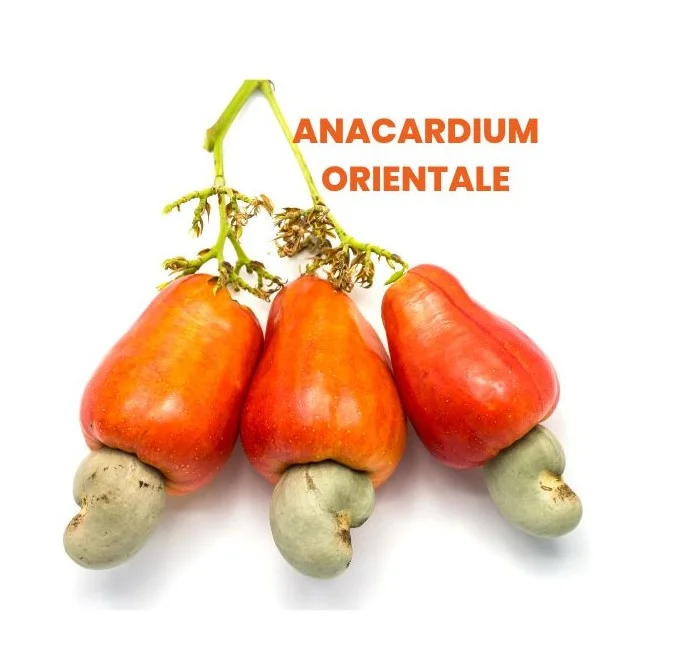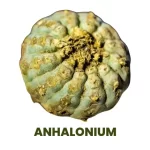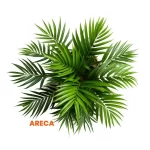Anacardium Orientale derived from the husk of the marking nut, is a unique homeopathic remedy with a diverse range of applications.
Known for its affinity to the Rhus family, especially different species of Rhus, Anacardium is recognized for its efficacy in addressing skin affections characterized by vesicular eruptions with intense burning and itching.
However, its most distinctive feature lies in its impact on mental symptoms.

Table of Contents
ToggleSOURCE INFORMATION
- Kingdom: Plantae
- Order: Sapindales
- Family: Anacardiaceae
- Genus: Anacardium
- Species: Anacardium Orientale
Common Name: Marking Nut
Origin: Anacardium orientale, commonly known as the Marking Nut, belongs to the Anacardiaceae family.
It is native to tropical areas of Asia, including India and Sri Lanka.
The plant thrives in a variety of soil types and is often found in deciduous forests.
Characteristics of the Plant
- Tree: Anacardium orientale is a medium-sized tropical tree with simple, leathery leaves and small greenish flowers.
- Fruit: The nut of the marking nut tree is enclosed in a fleshy, orange or red, kidney-shaped drupe. It is this nut that is commonly referred to as the marking nut.
Cultural and Traditional Use: The marking nut has historical significance in traditional medicine systems in India, where various parts of the plant, including the nut, resin, and bark, have been used for their medicinal properties.
Dr. Tyler’s Summary: Dr. Tyler, summarizing Anacardium, emphasizes its unique mental symptoms:
- “Anacardium, marking nut plugged sensation, eye to gut.”
- “Anacardium, here’s your guide, Plug within, tight band outside.”
- “Mentally two wills oppose, which to obey he never knows.”
SPHERES OF ACTION
- Mind and Nerves: Anacardium primarily acts on the mind and nerves, influencing mental states and cognitive functions.
- Stomach: It exhibits a sphere of action on the stomach, affecting digestive processes and addressing dyspepsia.
- Rectum: Anacardium’s impact extends to the rectum, making it useful in conditions like constipation and haemorrhoids.
- Skin: The remedy is applied in cases of skin affections, showcasing its dermatological sphere of action.
PATHOGENESIS
- Neurosyphilis: Anacardium is frequently employed in cases of neurosyphilis, specifically addressing brain fag associated with this condition.
- Nervous Dyspepsia: The remedy acts on nerves, producing a state known as nervous dyspepsia, emphasizing its influence on both the nervous and digestive systems.
CLINICAL APPLICATION
- Alcoholism: Dependence or addiction to alcohol.
- Abdominal affections: Issues or discomfort in the abdominal area.
- Brain fag: Mental fatigue or exhaustion.
- Constipation: Difficulty or infrequency in passing stools.
- Cough: Forceful expulsion of air from the lungs, often due to irritation.
- Debility: Weakness or lack of strength.
- Dyspepsia: Indigestion or upset stomach.
- Haemorrhoids: Swollen veins in the rectum or anus, also known as piles.
- Headache: Pain or discomfort in the head or neck region.
- Heart affection: Conditions affecting the heart.
- Loss of memory and mental weakness: Difficulty remembering or recalling information, along with mental fatigue.
- Nervous ailments: Disorders affecting the nervous system, such as anxiety or nervousness.
- Skin affection: Issues or conditions affecting the skin.
- Warts: Small, rough growths on the skin caused by a viral infection.
- Writer’s cramp: A type of muscle cramp or spasm that affects the hand muscles, often due to repetitive movements, such as writing.
CONSTITUTION
Physical Make-up: The individual’s physical appearance is characterized by a pale face, and there is a noticeable blue ring around the eyes.
Temperament: The person exhibits a temperament marked by high irritability. Even minor triggers or slight causes can result in an excessive and intense display of anger.
Relation with Heat and Cold: The individual does not have a particular preference for either hot or cold temperatures. The constitution is described as neither being overly sensitive to chilliness nor to heat.
Miasm: In the context of homeopathy, the background Miasmatic influences are noted to be Psora and Syphilis.
WHAT IS CONSTITUTION IN HOMOEOPATHY?
WHAT ARE TEMPERAMENTS IN HOMOEOPATHY?
DOCTRINE OF SIGNATURE OF ANACARDIUM ORIENTALE
The Doctrine of Signatures suggests that plants may bear a resemblance to the ailments they can treat, providing clues to their medicinal properties based on their physical characteristics.
In the case of Anacardium orientale, or commonly known as the marking nut or oriental cashew, its Doctrine of Signature is derived from its toxic nature and the appearance of its fruit.
Toxicity and Irritation
- The marking nut contains a toxic resin called urushiol, which is known to cause skin irritation, blistering, and inflammation upon contact.
- This toxic characteristic is reflected in the Doctrine of Signature, suggesting that the plant may have a relation to ailments associated with irritation, inflammation, and toxicity.
Markings and Symbolism
- The fruit of Anacardium orientale is characterized by a distinct marking or scar on its shell, resembling a human skull or brain.
- This peculiar marking is often interpreted symbolically, indicating a potential affinity for conditions affecting the brain, memory, cognition, or mental health.
- It may also symbolize the idea of duality or split personality, as reflected in the remedy’s psychological indications.
Split Nature
- Another aspect of the Doctrine of Signature associated with Anacardium orientale is its dual nature.
- The fruit of the marking nut tree contains both an outer shell and an inner kernel. This duality may symbolize the remedy’s potential to address conflicts, inner struggles, or contradictions within an individual, as reflected in its therapeutic indications for conditions such as indecision, inner conflict, and lack of confidence.
Overall, the Doctrine of Signature for Anacardium orientale suggests a correlation between its toxic properties, physical appearance, and therapeutic indications.
It highlights the plant’s potential to address ailments related to toxicity, irritation, mental health, and internal conflicts, based on its resemblance to certain physical and symbolic attributes.
GUIDING SYMPTOMS
1.All gone Sensation in stomach (Chel., lodum, Petroleum, Sepia).
- Feeling: Empty stomach sensation.
- When: Only when the stomach is empty.
- Relieved by: Eating and during digestion.
2. Plug-like sensation in inner parts
- Feeling: Like there is a blockage or plug.
- Where: Inner parts like anus, oesophagus, etc.
3. Constrictive sensation of a hoop or band around parts (Sulphur, Carbolic acid).
- Feeling: Tight band or hoop around body parts.
- Where: Head, knee, etc.
4. Great desire for Stool, but desire passes off without evacuation
- Feeling: Strong urge for a bowel movement.
- What happens: Desire disappears without having a bowel movement.
5. Symptoms prone to go from right to left (Lyco.)
- Movement: Symptoms tend to shift from the right side of the body to the left.
6. Ailments from: Conditions arise from negative impacts of mental excitement, overuse of the brain for unnecessary thoughts, consequences of fear and embarrassments, and a lifestyle involving prolonged sitting.
ANACARDIUM PSYCHOLOGICAL PROFILE
1. Parental Control & Fear of Punishment
- Raised in an environment of strict control and authoritarianism.
- Parents dictate every aspect of the child’s life, leaving no room for autonomy.
- Fear of severe punishment for disobedience or failure to meet expectations.
2. Internal Conflict
Two conflicting personas:
- Angelic obedience driven by fear.
- Malevolent tendencies emerging from suppressed rebellion and resentment.
3. Behavioural Responses
- Strives to meet imposed expectations to avoid punishment.
- Appears obedient, orderly, and fastidious externally.
- Internally battles with malicious, violent, and abusive tendencies.
4. Psychological Impact
- Develops a lack of self-confidence and nervousness due to constant scrutiny and fear of punishment.
- Irresolution stems from the anticipation of severe consequences for independent decisions.
5. Relationship Dynamics
- Submissive to dominating figures, leading to further self-doubt and confusion.
- May exhibit childish, timid behavior, lacking assertiveness and autonomy.
6. Manifestations & Symptoms
- Sudden loss of memory, including forgetting one’s own name and familiar places.
- Irresistible urge to curse and swear, expressing inner turmoil.
- Sensation of conflicting wills, torn between benevolent and malevolent impulses.
- Unusual temper fluctuations, laughing at serious matters and becoming serious over trivial issues.
- Paranoia and feeling of being followed, indicative of deep-seated anxiety.
- Great illusions, delusions, and hallucinations, blurring the line between reality and fantasy.
- Suspiciousness and tendency to take the negative side of situations, leading to violent outbursts.
- Acts of self-harm as a manifestation of internal conflict and lack of self-worth.
- Absent-mindedness and hypochondria, reflecting internal distress and preoccupation.
- Chronic lack of confidence in oneself and others, rooted in years of psychological manipulation.
- Persistent anxiety and foreboding of impending misfortune, stemming from a sense of helplessness and insecurity.
7. Compensated State
- In some cases, inability to exhibit cruelty even when circumstances demand it, indicative of an internal struggle between the two personas.
Overall, Anacardium patients carry the burden of a fractured psyche, torn between the angelic obedience enforced by external pressures and the malevolent rebellion born out of suppressed autonomy and resentment.
Their psychological landscape is marked by deep-seated fear, internal conflict, and a pervasive sense of inadequacy, resulting in a complex array of symptoms and behaviours.
PARTICULARS
HEADACHE
Causation
Nervous headache prevalent among sedentary individuals.
Triggered by anxiety, fear, or sudden fright.
Location: Forehead, temples, vertex, and occiput.
Sensation: Feeling of a plug in the inner part of the head.
Character of Pain: Pressing pain akin to the sensation of a plug in the inner part of the head.
Modalities
Aggravation
- Mental exertion.
- Empty stomach.
Amelioration
- Lying down.
- Eating.
- Falling asleep.
GASTRO-INTESTINAL SYMPTOMS
STOMACH
Causation: Associated with sedentary habits.
Sensation: Feeling of “all gone” in the stomach.
Character
- Typical of gastric headache observed in individuals leading a sedentary lifestyle.
- Occurs after hurried eating and drinking, often with a choking sensation while swallowing.
- Intense “all gone” sensation in the stomach when it’s empty.
Modalities
- Aggravation: Empty stomach.
- Relief: Eating.
RECTUM
- Presents with paretic weakness or paralysis of the rectum.
- Great desire for stool, but upon effort, the desire fades without evacuation.
- Sensation of a plug in the rectum.
SKIN SYMPTOMS
Appearance
- Erysipelatous eruptions with a malignant nature.
- Yellow vesicles characterized by intense burning and itching.
- Presence of warts on the palm of the hand (similar to Natrum mur.).
- Eczema with marked mental irritability; itching persists despite scratching.
- Associated with Lichen Planus and neurotic eczema.
- Anaesthetic patches observed in leprosy, accompanied by ulcer formation and trophic ulcers.
Modality: Aggravation from hot applications.
Concomitants: Intense itching, a common accompanying symptom.
GENERAL MODALITIES
Aggravation: Worsening of symptoms during motion, mental exertion, and on an empty stomach.
Amelioration: Improvement observed after eating, lying down, and falling asleep.
WHAT ARE MODALITIES IN HOMOEOPATHY?
RELATIONS
Antidote: Rhus tox., Coffea.
Follows Well After
Lyco., Puls.
Specifically follows well after Lyco. and Puls.
Followed By
Platina.
DOSE
- Recommended in potencies ranging from sixth to two hundredth.













Leave a Reply